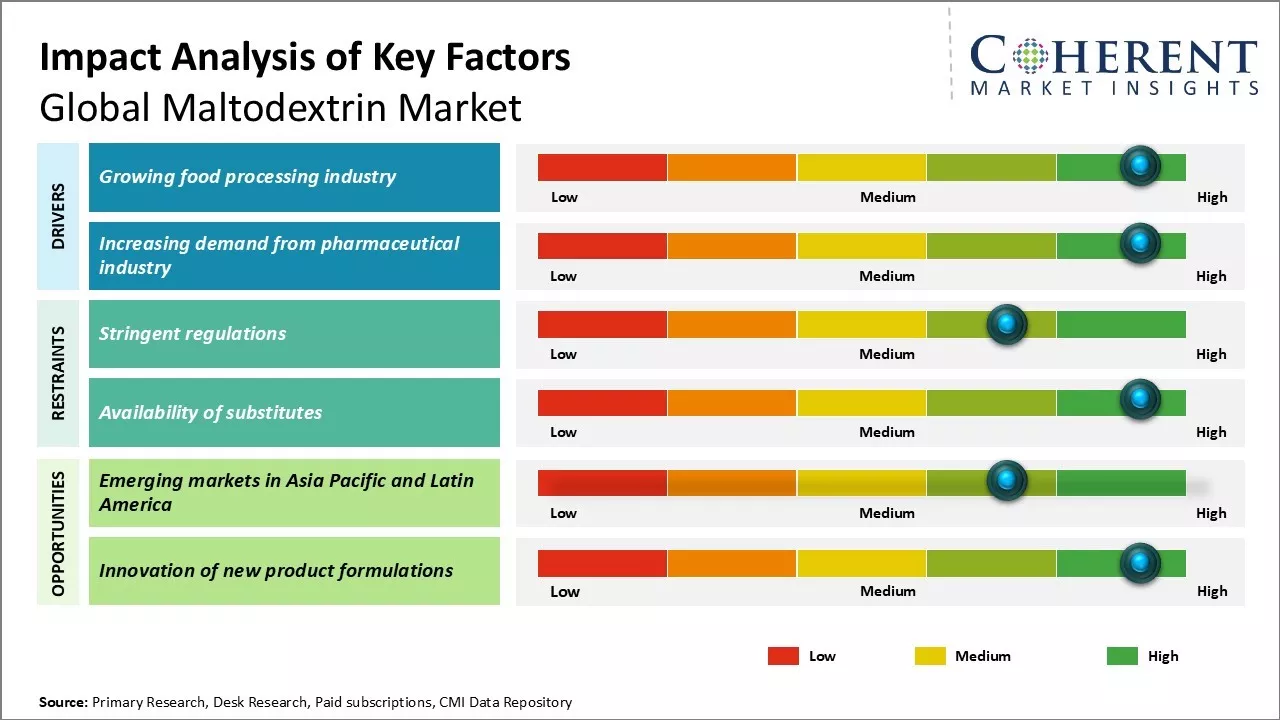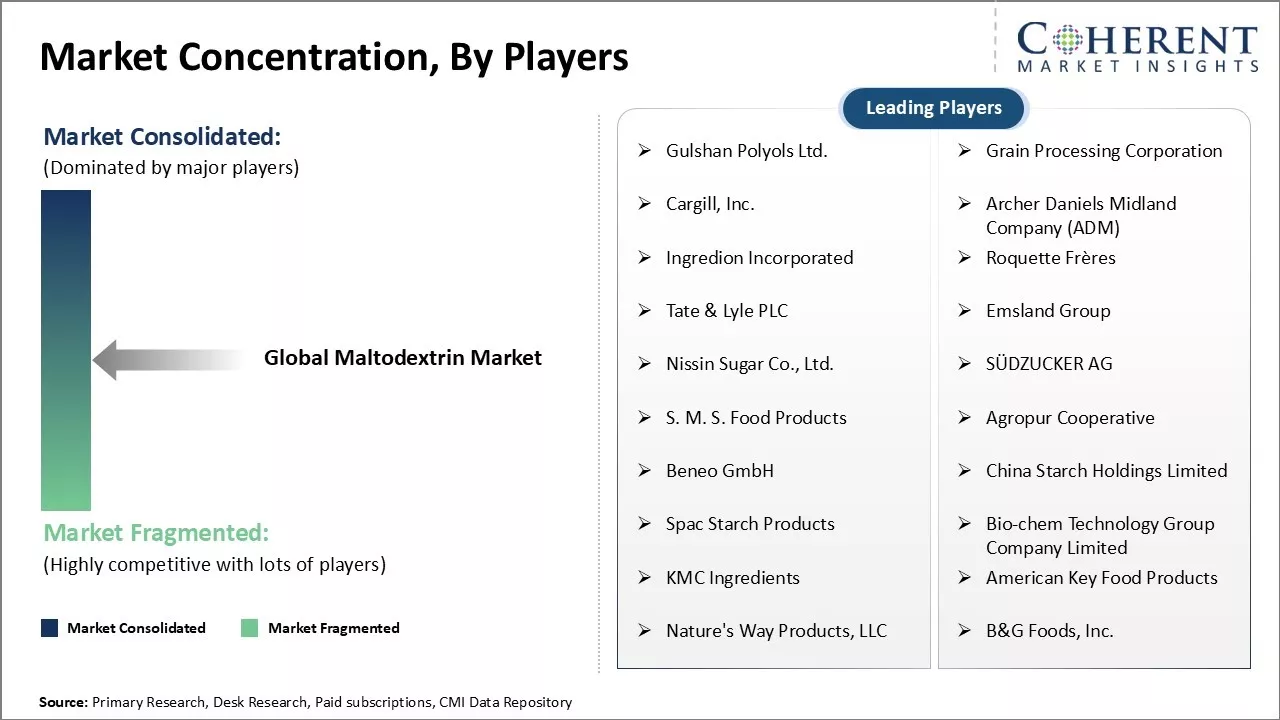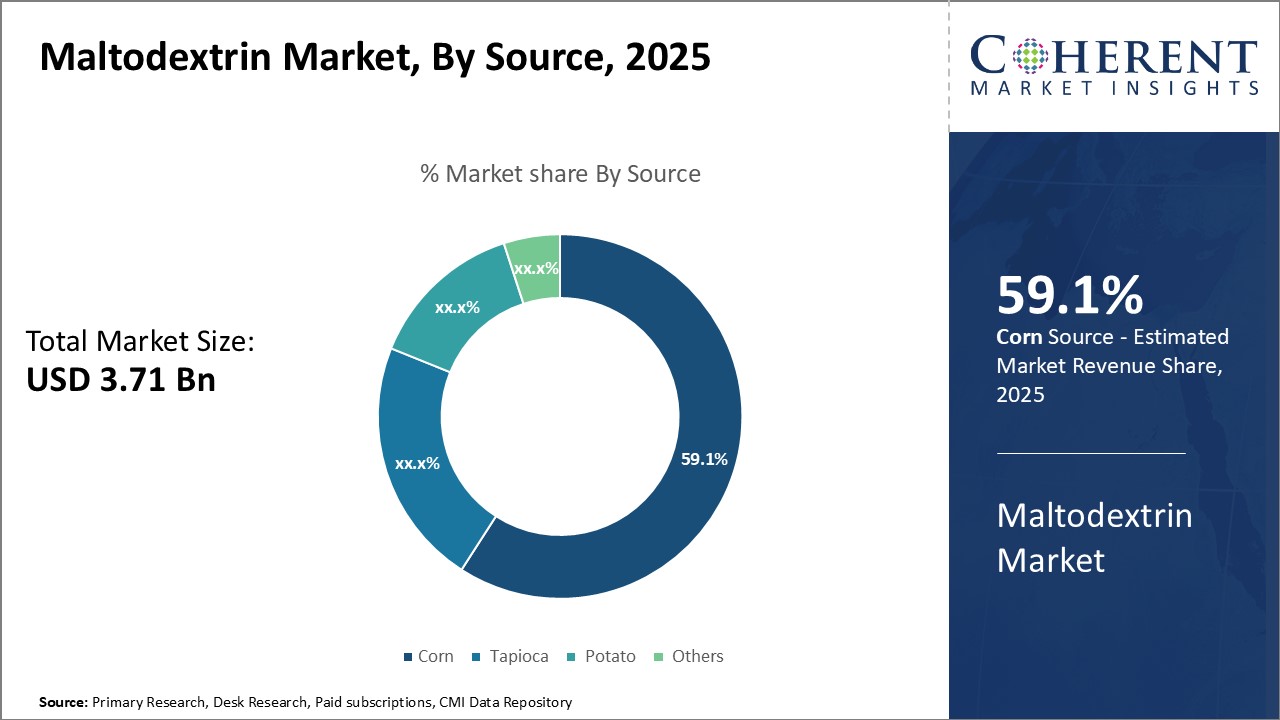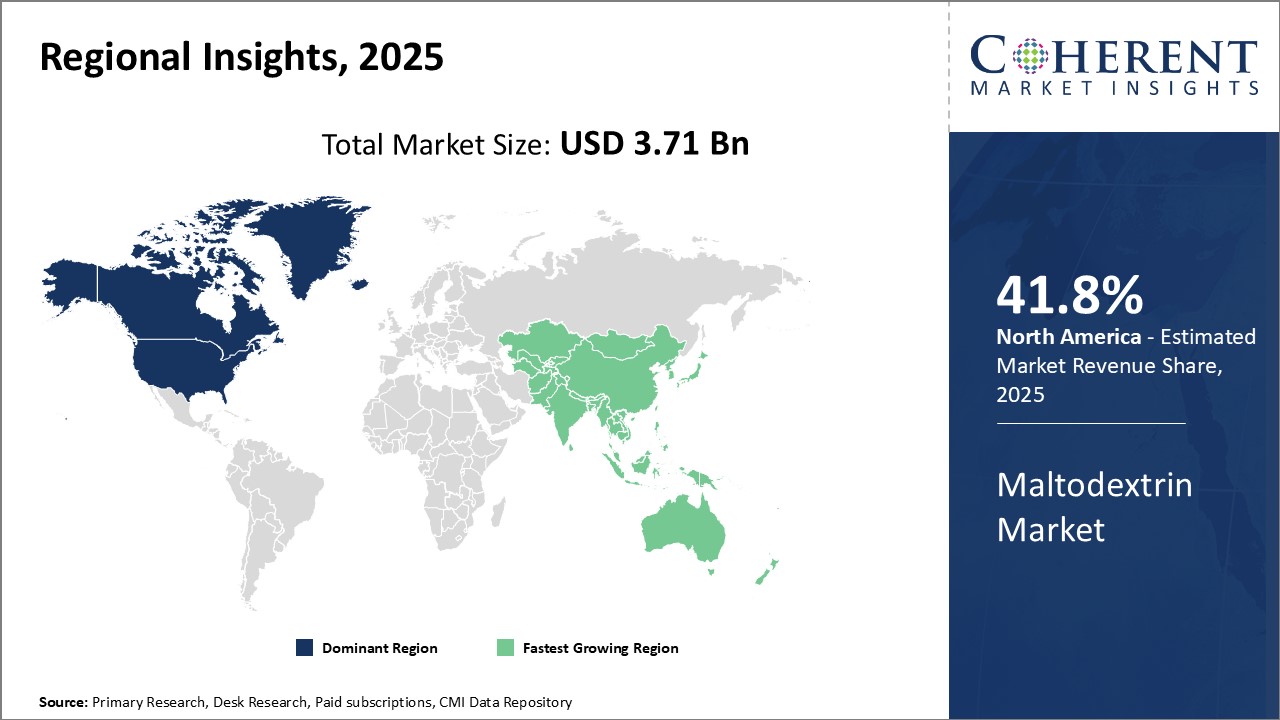The global maltodextrin market is estimated to be valued at USD 3.71 Bn in 2025 and is expected to reach USD 5.47 Bn by 2032, exhibiting a compound annual growth rate (CAGR) of 5.7% from 2025 to 2032.

Discover market dynamics shaping the industry: Request sample copy
Increasing demand from the food and beverage industry is expected to boost the market growth. Maltodextrin is widely used in various food products such as candy, ice cream, dairy products, etc. as a stabilizer, thickener, and texturizer. Its ability to provide body, texture, and volume to products without altering the taste makes it a preferred choice in the food industry. Rising health awareness among people has been increasing the demand for low-calorie, sugar-free, and low-fat food products which is expected to drive the demand for maltodextrin. The expanding packaged food industry globally along with rising disposable income is further expected to propel the market growth during the forecast period.
Market Driver - Growing food processing industry
The global food processing industry has undergone tremendous growth over the past couple of decades. Changing dietary habits and lifestyles have led to a surge in demand for processed and packaged foods worldwide. Population growth, urbanization, and rising disposable incomes in developing economies have particularly boosted consumption of packaged food products. Maltodextrin happens to be an important thickening and texturizing agent commonly used in various processed foods and beverages.
Maltodextrin is utilized in different applications such as dried food mixes, sauces & dressings, snack foods, confectionery, bakery items and soup mixes among others. It helps improve consistency, prevent caking and assists in solubilization. The rising sales volumes of packaged foods where maltodextrin is widely added as an anticaking agent and bulking agent has significantly augmented the demand from the food processing segment. With increasing demand for healthy and convenient ready-to-eat food options particularly in urban areas, food manufacturers are coming up with more new product launches and line extensions every year requiring use of additives and thickeners like maltodextrin.
Sustained expansion of the food manufacturing industry in developing regions where consumption of ready meals and snacks is growing rapidly has created favorable conditions for maltodextrin consumption. Asia Pacific has emerged as the leading production hub for packaged foods and it also represents one of the most lucrative markets for maltodextrin globally. The growing focus on food security along with changing consumer patterns has accelerated investments in food processing infrastructure and new product development activities in Asia and other emerging economies. This in turn is expected to further drive the adoption of commercial starches and modify starches like maltodextrin through the forecast period.

Get actionable strategies to beat competition: Request sample copy
Increasing Demand from Pharmaceutical Industry
The pharmaceutical industry has exhibited accelerated growth rates worldwide attributed to rising healthcare spending, increasing prevalence of chronic diseases and growing geriatric population. Maltodextrin has numerous medical applications as an excipient and additive in tablets, capsules, syrups, ointments and other oral and topical dosage forms. It is widely used as a bulking agent, binder, coating agent, and masking agent during drug formulation processes.
Key features of maltodextrin like excellent solubility, low cost, and stability make it a preferred choice for oral drug delivery matrices. It facilitates the production of uniform capsules and tablets with good flow and compression properties. Moreover, maltodextrin also helps mask unpleasant tastes and odors of certain active pharmaceutical ingredients. With growing R&D investments of pharmaceutical companies in developing innovative drug delivery systems, the utility of functional excipients such as maltodextrin has been increasing substantially.
As life expectancy increases globally accompanied by rising healthcare awareness, pharmaceutical sales are expected to surge in the future. This expanding pharmaceutical market represents strong growth prospects for maltodextrin due to its essential role in manufacturing a diverse array of drug formulations. Moreover, rapid advancements taking place in areas like biotherapeutics, regenerative medicine, and personalized drugs also indicate heightened demand for multifunctional excipients like maltodextrin, supporting complex drug delivery approaches.
Key Takeaways from Analyst:
The food and beverage industry will continue being the largest end user of maltodextrin due to its wide applications in products such as soups, sauces, dairy items, and frozen foods. Developing regions of Asia Pacific and Latin America are likely to see higher demand growth compared to mature markets of North America and Western Europe due to rising disposable incomes and growing health consciousness.
Maltodextrin is a low-cost sugar substitute and its demand may rise further with the trend of replacing sugar with low-calorie sweeteners. However, the market could face some restraints from the increasing popularity of natural ingredients among health-conscious consumers.
Alternative sweeteners like stevia and tagatose may restrict the market growth to some extent. Corn-based maltodextrin dominates the market but tapioca and potato variants could gain traction, driven mainly by preferences for non-GMO ingredients in developed regions. While demand for spray-dried maltodextrin is expected to remain strong, sales of acid-hydrolyzed maltodextrin may increase faster owing to its low pH value and easy solubility.
Market Challenges: Stringent regulations
The global maltodextrin market is facing stringent regulations regarding the usage of certain ingredients and production processes. Various regulatory bodies around the world have implemented regulations to ensure the quality and safety of maltodextrin used in various applications. For example, the FDA has stringent Generally Recognized as Safe (GRAS) standards that manufacturers need to adhere to. Similarly, the European Union Food Safety Authority (EFSA) has laid down limits on certain impurities allowed in malodextrin. Complying with varying and evolving international standards requires substantial investments from maltodextrin producers. This increases the cost of operations and also reduces profit margins. Additionally, inability to meet a certain regulation can impact product approvals and market access. Overall, the regulatory complexities pose a notable challenge for maltodextrin market players regarding quality control and infrastructure upgradation.
Market Opportunities: Emerging Markets in Asia Pacific and Latin America
The maltodextrin markets in Asia Pacific and Latin America offer significant growth opportunities for leading global players. In the Asia Pacific region, countries like China, India, Indonesia, and Vietnam are expected to drive high demand in the upcoming years. Rising population, growing middle-class, and increasing consumption of packaged food products will bolster the market growth. Similarly, Latin American nations of Brazil, Mexico, Argentina, and Colombia represent untapped markets with steady socio-economic development. Price-sensitive consumers in these emerging regions offer an attractive value-for-money proposition for maltodextrin producers. Leading companies can gain an early mover advantage through strategic partnerships, acquisitions, and by localizing production facilities. Overall, Asia Pacific and Latin America present lucrative expansion opportunities for maltodextrin market players due to developing market conditions and evolving consumption patterns in these regions.

Discover high revenue pocket segments and roadmap to it: Request sample copy
Insights by Source: Corn's Versatile Nature Drives Its Dominance in the Maltodextrin Source Segment
In terms of source, corn is expected to contribute 59.1% share of the market in 2025, owing to its versatile nature and abundant availability. Corn is a highly versatile crop that is efficiently grown across diverse geographies and climates worldwide. It offers maltodextrin producers a reliable and consistent source of starch. Corn starch extraction and processing is also well-established, facilitating large-scale and cost-effective maltodextrin production. Additionally, corn is one of the most abundantly grown crops globally, ensuring adequate supply to meet the burgeoning demand for maltodextrin. Its widespread cultivation has optimized agricultural practices and logistics, maintaining competitive prices. These advantages have enabled corn to gain widespread preference among maltodextrin manufacturers over alternatives like tapioca and potato. Going forward, extensive corn cultivation and efficient production infrastructure are expected to reinforce its leading position in the source segment.
Insights by Form: Dry Form Drives Product Versatility and Storage Stability
In terms of form, dry maltodextrin is expected to contribute 56.8% share in 2025, owing to advantages over liquid maltodextrin in terms of product versatility and storage stability. Dry maltodextrin maintains a longer shelf life as it can be stored at room temperature without refrigeration. This makes it more compatible for storage and transport. Moreover, dry form increases the usefulness of maltodextrin as it can be easily mixed into various food and other formulations without affecting texture or consistency. Liquid maltodextrin needs to be dried during processing, adding an extra production step. Dry maltodextrin also improves handling and prevents clumping during packaging. Owing to these benefits, dry maltodextrin sees wider application across industries like food, beverages, pharmaceuticals, and personal care. Its versatility and stability have enabled dry maltodextrin to emerge as the preferred format among producers.
Insights by Application: Rising Food Demand Boosts Maltodextrin Usage in Food & Beverages
In terms of application, the food & beverages segment is expected to contribute 35% of the market share in 2025, driven by the rising global demand for convenience and packaged food products. Maltodextrin finds extensive use as a stabilizer, thickener, and bulking agent in various convenience foods, bakery products, and beverages. It helps maintain texture, serves as a filler and reduces costs. The addition of maltodextrin increases the shelf life of foods while retaining their taste and appearance. The robust growth of the packaged food industry can be attributed to busy lifestyles and changing dietary habits. Ready-to-eat foods enriched with nutrients are gaining traction. Maltodextrin addresses the needs of manufacturers to produce affordable packaged foods without compromising on quality. This growing packaged food culture will continue bolstering the demand for maltodextrin from the food & beverage industry in the foreseeable future.

Need a Different Region or Segment? Customize now
North America currently dominates the global maltodextrin market. The region is expected to account for 41.8% of the market share in 2025, leveraging strong industry presence and production capabilities in the region. The U.S. is the largest producer and consumer of maltodextrin globally. This can be attributed to robust demand from key end-use industries such as food & beverage, pharmaceutical, and paper manufacturing. Major brands source high quality native cornstarch to brew maltodextrin ingredients and supply to various domestic and international clients. Further, the region also has strategic trade partnerships with emerging economies in Asia Pacific and Middle East & Africa, which benefit exports.
Meanwhile, Asia Pacific has emerged as the fastest growing regional market for maltodextrin. This phenomenal growth can be supported by rising health-conscious population, growing disposable incomes, and increasing western influence in daily diets across developing nations. In particular, China and India are displaying exponential expansion on the back of flourishing food processing industry and massive imports of high fructose corn syrup and other starch products. Local producers are amplifying production scale through advanced brewing technologies to fulfil the mammoth indigenous requirement for bakery & confectionery applications as well as Infant formulas. Besides, Southeast Asian countries also represent an untapped market due to improving economic landscapes and shifting focus towards convenience foods and beverages.
Maltodextrin Market Report Coverage
| Report Coverage | Details | ||
|---|---|---|---|
| Base Year: | 2024 | Market Size in 2025: | USD 3.71 Bn |
| Historical Data for: | 2020 To 2024 | Forecast Period: | 2025 To 2032 |
| Forecast Period 2025 to 2032 CAGR: | 5.7% | 2032 Value Projection: | USD 5.47 Bn |
| Geographies covered: |
|
||
| Segments covered: |
|
||
| Companies covered: |
Gulshan Polyols Ltd., Grain Processing Corporation, Cargill, Inc., Archer Daniels Midland Company (ADM), Ingredion Incorporated, Roquette Frères, Tate & Lyle PLC, Emsland Group, Nissin Sugar Co., Ltd., SÜDZUCKER AG, S. M. S. Food Products, Agropur Cooperative, Beneo GmbH, China Starch Holdings Limited, Spac Starch Products, Bio-chem Technology Group Company Limited, KMC Ingredients, American Key Food Products, Nature's Way Products, LLC, and B&G Foods, Inc. |
||
| Growth Drivers: |
|
||
| Restraints & Challenges: |
|
||
Uncover macros and micros vetted on 75+ parameters: Get instant access to report
*Definition: The global maltodextrin market is used to describe the business of manufacturing and selling maltodextrin, a polysaccharide that is used as an easily digestible carbohydrate in many food applications. Maltodextrin is made from starch hydrolysis and is commonly used as a food additive and thickening agent. The global market covers the production, distribution, and sales of maltodextrin worldwide. Key players in this market source raw ingredients like corn or potato starch to produce maltodextrin in powdered or liquid form for a variety of food industry applications.
Share
Share
About Author
Kalpesh Gharte is a senior consultant with approximately 5 years of experience in the consulting industry. Kalpesh holds an MBA in Operations and Marketing Management, providing him with a strong foundation in market strategy and analysis. He has contributed to various consulting and syndicated reports, delivering valuable insights that support informed business decisions
Missing comfort of reading report in your local language? Find your preferred language :
Transform your Strategy with Exclusive Trending Reports :
Frequently Asked Questions
Joining thousands of companies around the world committed to making the Excellent Business Solutions.
View All Our Clients
US Reciprocal Tax Impact Analysis On Maltodextrin Market
Stay updated on tariff changes with expert insights and timely information